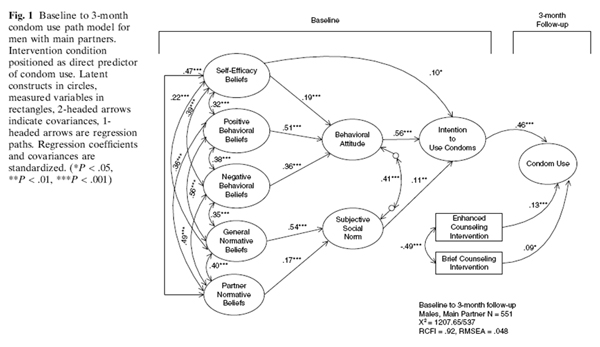Source:
Rhodes F, Stein JA, Fishbein M, Goldstein RB, Rotheram-Borus MJ. Using theory to understand how interventions work: Project RESPECT, condom-use, and the integrative model. AIDS Behav. 2007:11; 393-407.
- Using Structural Equation Modeling (SEM), this study assesses how IBM constructs can be applied to condom use behavior. IBM constructs were assessed before and immediately after the delivery of Project RESPECT, an HIV / AIDS intervention.
- The goal of Project RESPECT was to increase the likelihood that a male condom would always be used for vaginal sex with main and casual partners. Activities were designed to improve perceived self-efficacy toward condom use, to encourage positive attitudes towards always using condoms, and to set expectations that condom use is normative among partners and friends / acquaintances.
- Study took a subset of RESPECT subjects assigned to three different intervention arms:
- Enhanced Counseling
- Brief Counseling
- Didactic Message.
- The IBM was tested
- between baseline and 3 month follow-up
- between immediate follow-up and 3 month follow-up
- Separate models were created for those participants who reported casual partners and for those who had main partners exclusively. The main partner sample was divided by gender. There were, thus, six analyses.
- Components of the IBM monitored at the time of recruitment generally predicted condom use 3 months later. Across both main and casual partners, the prediction of condom use intention from behavioral attitude, self-efficacy, and subjective social norms was validated by SEM. Depending on participants gender and type of partner, different components of the IBM were relatively more or less important as determinants of condom use intentions.
Source:
Rhodes F, Stein JA, Fishbein M, Goldstein RB, Rotheram-Borus MJ. Using theory to understand how interventions work: Project RESPECT, condom-use, and the integrative model. AIDS Behav. 2007:11; 393-407.
- Measures:
- Self-efficacy: five indicators of how certain participants were that they could use condoms or get their partners to use condoms under different conditions
- Positive behavioral beliefs: the strengths of beliefs that always using a condom would lead to positive consequences on a five point scale (i.e. "it would make you feel cleaner", "it would show your partner that you care")
- Negative behavioral beliefs: the strengths of beliefs that always using a condom would lead to negative consequences (i.e. "sex would be painful or uncomfortable")
- General normative beliefs: five items that asked whether friends, families, doctors, church / religion, and the health department thought the respondent should always use a condom (five point scale)
- Partner normative beliefs: one item that asked if the partner felt the respondent should / should not use a condom
- Behavioral attitude: seven bipolar paired items about always using condoms (one stem, seven sets of response options, scaled 1-7)
- Subjective social norms: one item evaluated whether respondent believed their important others thought they should always use a condom (scaled 1-7)
- Intention: one item, scaled 1-7, assessing how likely it was that respondents would use always use condom with their partners in the next 6 months
- Condom use: three self-report items, (a) based on condom use frequency in past 30 days (b) condom use at the last sexual event (c) condom use percentage in the past three months

Example of SEM results.
Sources: Rhodes F, Stein JA, Fishbein M, Goldstein RB, Rotheram-Borus MJ. Using theory to understand how interventions work: Project RESPECT, condom-use, and the integrative model. AIDS Behav. 2007:11; 393-407.
